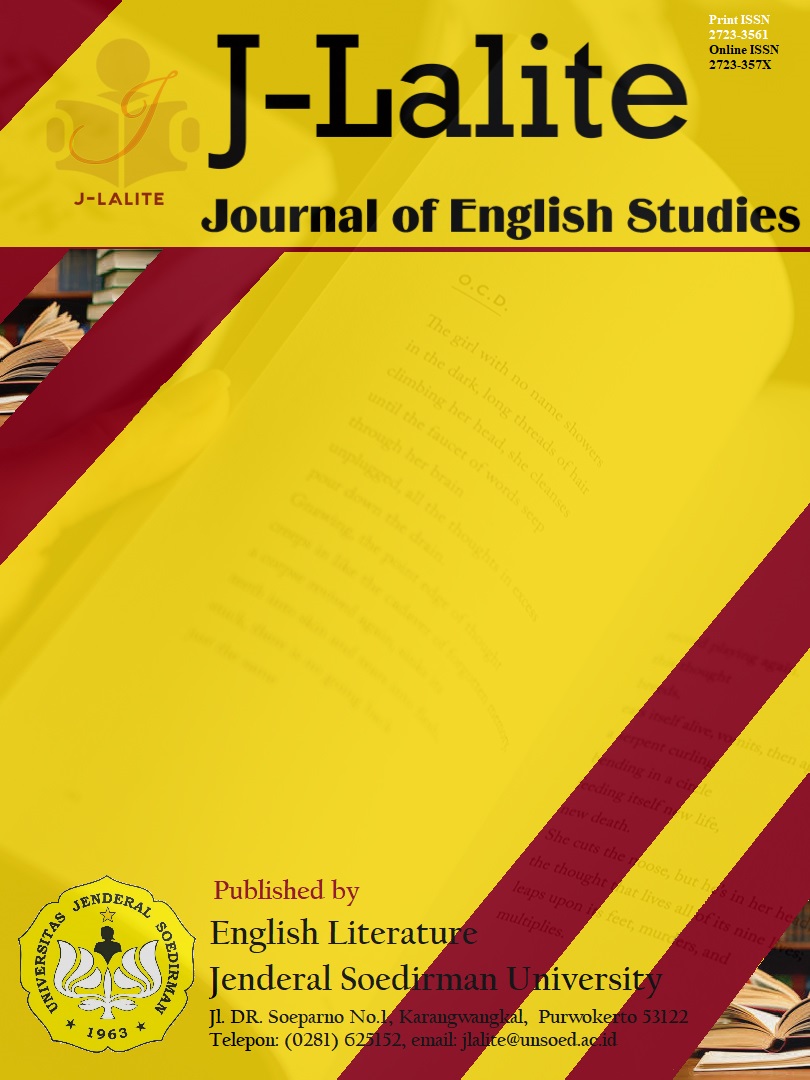A Stylistic Analysis of Imperative Mood on Hannah Baker’s Monologue - 13 Reasons Why (Season 1)
Abstract
The appearance of a sentence that is continuously uttered by the speaker becomes a style or characteristic of the speaker. This can be seen in a series entitled 13 Reasons Why in which the main character, Hannah Baker, uttered many imperative moods. This research focuses on how the use of one form of sentences, namely imperative or what is called as imperative mood, can give a stylistic effect that appears on the utterances of Hannah Baker in a monologue. This research uses a qualitative method that aims 1) to find out the forms of the imperative mood; and 2) to find out the functions of the form of the imperative mood using the theory of Aikhenvald (2010). By observing and transcribing, the data can be found, which then can be identified to find out the imperative sentence, what form and function of it. Through these things, a conclusion can be drawn about how the character of Hannah Baker's is seen from the imperative mood that she utters and what meaning she wants to convey through the imperative mood. This research uses purposive sampling in collecting the data. Based on the results of the study, 54 imperatives mood were found in the monologue. The findings reveal two forms of imperatives namely canonical imperative as many as 77.78% and non-canonical imperative as many as 22.22%. The functions of imperatives found include: 1. Orders, commands, demands (only commands), 2. Requests, pleas, entreaties, 3. Advice, recommendations, warnings, 4. Instructions and expository directives, 5. Invitations, 6. Permission, 7. Acceptance, 8. Incredulous rejection, and 9. Self-deliberation. From the results obtained, it can be seen that the most dominant function is instruction, which is 16.67%. From this result, it can be known that Hannah Baker wanted to show each incident in detail that caused her suicide through her monologue in 13 Reasons Why (Season 1).
References
Creswell, J. W. (2007). Qualitative Inquiry & Research Design: Choosing Among Five Approaches. 2nd ed. California: SAGE Publications, Inc.
Creswell, J. W. (2014). Research Design Qualitative, Quantitative, and Mixed Methods Approaches. 4th ed. California: SAGE Publications, Inc.
Downing, A., & Locke, P. (2006). English Grammar. 2nd ed. New York: Routledge.
Kane, T. S. (2000). The Oxford Essential Guide to Writing. New York: Berkley Books.
Netflix.com. (2019). Netflix. [Online]. Retrieved from: https://www.netflix.com/iden/browse/genre/839338 [Accessed on November 3, 2019]
Ross, B. (2020). First, Second, and Third Person. Grammarly Inc. [Online]. Retrieved from: https://www.grammarly.com/blog/first-second-and-thirdperson/.[ Accessed on March 5, 2020]
Simpson, P. (2004). Stylistics: A Resource Book for Students. London: Routledge.
Tvsubtitles.net. (2019). [Online]. Retrieved from: http://www.tvsubtitles.net/tvshow2201-1.html . [Accessed on November 3, 2019]
Wright, L., andHope, J. (1996). Stylistic: A Practical Course book. London: Routledge.
----------. (2008). Oxford Learner’s Pocket Dictionary. 4th ed. New York: Oxford University Press.
----------. (2016). On Non-Finiteness and Canonical Imperatives. John Benjamins Publishing Company. [Online]. Retrieved from: https://benjamins.com/catalog/tsl.113.10hei. [Accessed on October 15, 2019]
----------. (2019). Stylistic Devices – Parallelism. English Grammar Online. [Online]. Retrieved from: https://www.ego4u.com/en/cram-up/writing/style. [Accessed on November 26, 2019]
By submitting the manuscript, the author(s) agreed to these following terms:
(1) The copyright of received articles shall be assigned to J-Lalite: Journal of English Studies as the publisher of the journal. The intended copyright includes the right to publish articles in various forms (including reprint). J-Lalite: Journal of English Studies maintain the publishing rights to the published articles.
(2) Author(s) are permitted to disseminate published articles by sharing the link/DOI of the article at J-Lalite: Journal of English Studies. Author(s) are allowed to use their articles for any legal purposes deemed necessary without written permission from J-Lalite: Journal of English Studies with an acknowledgement of initial publication to this journal.
(3) Authors should sign a copyright transfer agreement when they have approved the final proofs sent by J-Lalite: Journal of English Studies prior to the publication.
(4) User/public use of this website will be licensed to Creative Commons Attribution-ShareALike 4.0 International (CC BY-SA 4.0) License.







.png)
.png)
.png)
.png)




